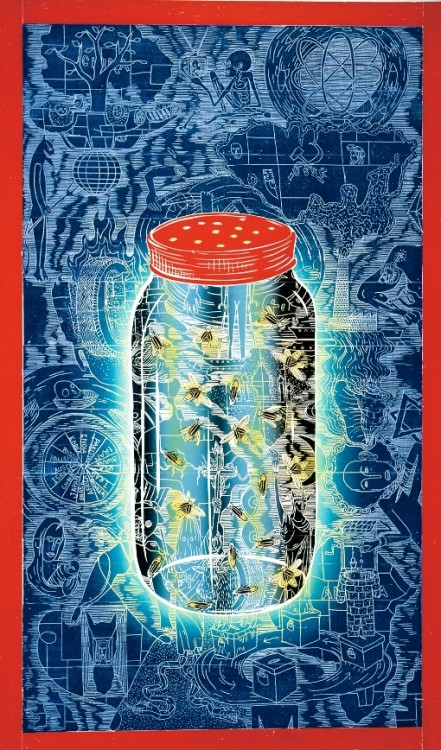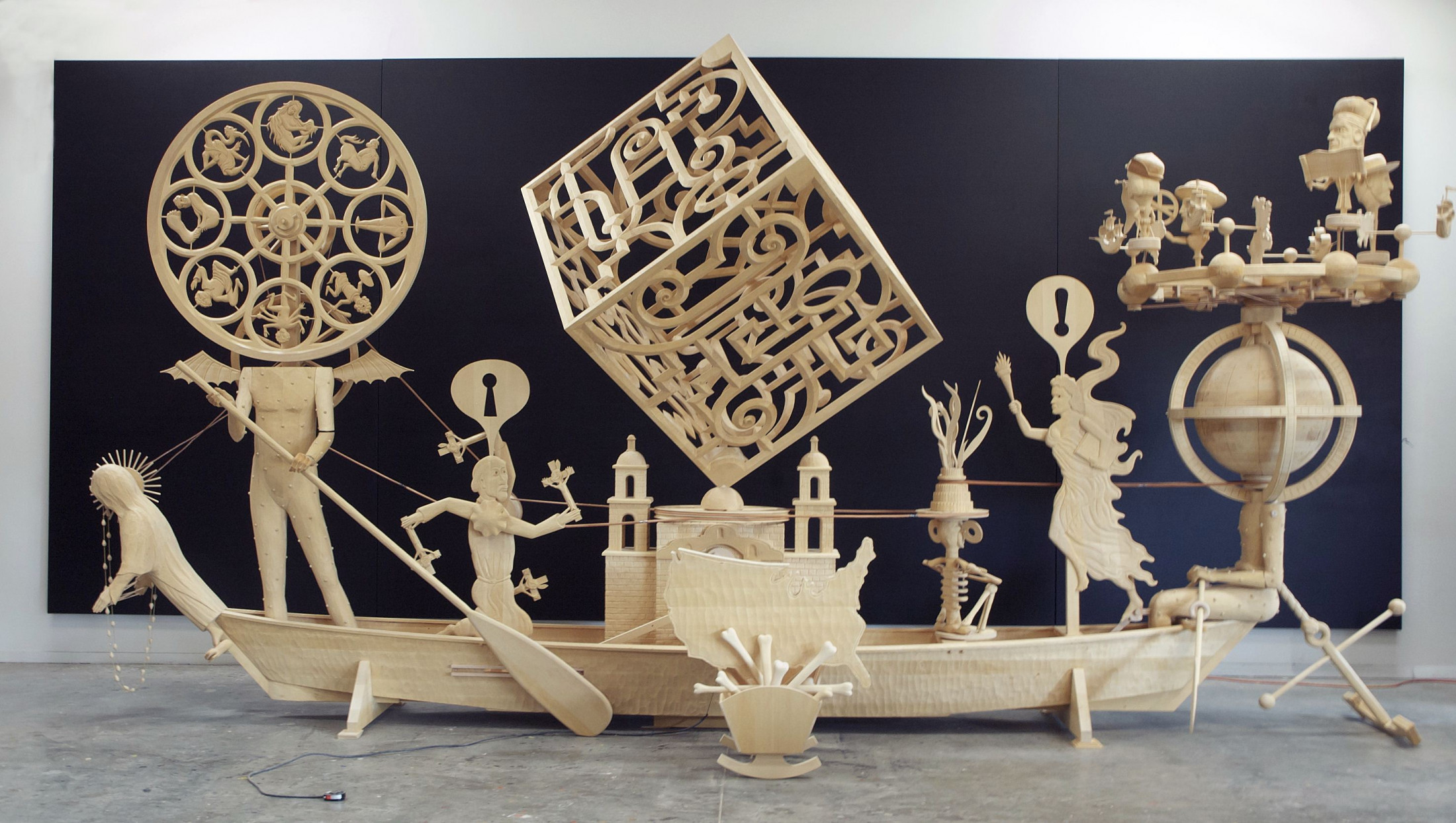John Buck: Free For All
September 25 2015 - March 12 2016
John Buck is a dynamic artist widely known for his carved wood and bronze sculptures and large woodblock prints that incorporate a variety of diverse imagery. Recently, the artist has been creating largescale mechanical kinetic sculptures. On the event of MAM’s 40th anniversary, the museum will realize its longstanding desire to host a solo exhibition of Buck’s work. The scale of his sculptural work requires an installation in two of MAM’s larger spaces, the Carnegie and the Aresty galleries. The exhibition includes a mix of sculptures and prints on loan from the artist, paired with select works borrowed from the collections of the Jordan Schnitzer Family Foundation. The exhibition will premiere Buck’s most recently completed kinetic sculpture State of the Union.
State of the Union includes a host of signs and signifiers that convey a dense narrative typical of Buck’s signature approach. Motors engage leather belts and carved gears. Cogs spin. Wheels turn. Heads rotate and rock. Figures move in elaborate gestures. Objects come closer then move away. Motion, however, is only the most immediate sensory experience. His sculptures, comprising a vast array of objects and symbols, offer profound and layered messages often with a pointed social or political undertone.
Art historians and critics often attempt to include artists in particular art historical movements, but the challenge of how to frame Buck’s significant production is self-evident. MAM curator emeritus Stephen Glueckert states, “using monikers such as ‘modernist’ or ‘post-modernist’ can seem really silly when thinking about Buck’s work…I would most humbly assert that he is an artist who tries to be realistic in telling a more accurate story… that the artist’s shapes, forms, and motion can tell a more engaged and encompassing story than words in history books. Artist’s stories are sometimes laced with irony. This is especially true in the language he uses…I think of him as ‘a realist’.”
Buck’s love of materials, attention to composition, and sensitivity to surface and color are all the characteristics that reflect his obsessive thinking process. The artist states, “The nature of my sculptures is that they are compositions that balance the weight of form and imagery. I think of my carvings as being somewhat matter-of-fact. If there is any appeal to this, it is due to the nature of the wood. The unfinished wood has a warm glow resembling flesh.”
Greg Kucera, whose gallery represents the artist in Seattle, states, “Buck uses jelutong wood as his primary material. It is a soft, white wood culled from Malaysian farming operations. Too soft to have any value as a building material, it is perfectly suited to the furniture maker and wood sculptor. The process of its own making becomes very apparent in the finished piece. Each hack mark and chisel cut remains visible.”
Buck’s artwork, however, is not constructed for the sake of formality. Even though it is obvious that he enjoys the materials and creative process, his sculptures and prints address very real concerns. His work has a profound directness that targets casual inhumanity, outright stupidity, or gross negligence. While these kinetic works feel playful, Buck elucidates his observations of the fragility of the human condition and his feeling of helplessness about the impending consequences of human action.
Buck has created acting and moving instruments with a potent message. Like many storytellers and balladeers, the artist has a soft side and a dark side. That contrast of light and dark is something that seems completely consistent and natural in Buck’s work. From Daumier and Goya to Picasso, artists have wrestled with depicting current social and political affairs, seeking to offer commentary and resolution through their artwork. In our time, Buck takes on this important role. But for artists like Buck, this is not a choice; it is an imperative.
Buck was born in Ames, Iowa, and received his BFA from the Kansas City Art Institute in Missouri. He went on to study at the Skowhegan School of Painting and Sculpture in Maine and received his MFA from the University of California, Davis. He has lived much of his life between two homes, one in Bozeman and the other on the Big Island of Hawaii. Montana is fortunate to have Buck as a supportive and inspirational presence in the state. Buck and his wife, sculptor Deborah Butterfield, were awarded the Governor’s Arts Award in 2010.
Buck’s work has been widely exhibited throughout the United States and is included in numerous private and public collections, including Fine Arts Museum of San Francisco, Art Institute of Chicago; the Brooklyn Museum, Contemporary Arts Center in Honolulu, Denver Art Museum, the Museum of Modern Art in New York City, San Francisco Museum of Modern Art, Seattle Art Museum, and the Missoula Art Museum.
While this exhibition is intended for art connoisseurs of all ages, it is the foundation of the Fifth Grade Art Experience in 2015. MAM is fortunate to share this rich exhibition and a related hands-on experience with every fifth-grade student in Missoula, Lake, and Ravalli Counties
through funding from the Jordan Schnitzer Family Foundation and the Art Associates of Missoula. Special thanks go to the Missoulian for media sponsorship. Lastly, MAM would like to thank John Buck’s support team, particularly Dawn Ahlert and Guy Klaus, MAM installers, and Rocky Mountain Moving and Storage.

John Buck, The Lamp, color woodcut, 1995, collection of the artist, copyright the artist.


